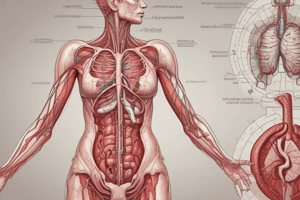Podcast
Questions and Answers
What is the primary function of gamma globulins in plasma proteins?
What is the primary function of gamma globulins in plasma proteins?
- Transport of hormones
- Clotting factors
- Buffering capacity
- Immunity (correct)
Which cells primarily produce gamma globulins in adults?
Which cells primarily produce gamma globulins in adults?
- Endothelial cells
- Mesenchymal cells
- Reticuloendothelial cells
- B-lymphocytes (correct)
What is the result of plasmapheresis in therapeutic procedures?
What is the result of plasmapheresis in therapeutic procedures?
- Increased blood volume
- Removal of red blood cells
- Separation of plasma from cells (correct)
- Decrease in gamma globulin levels
Which of the following is a hormone that regulates blood volume?
Which of the following is a hormone that regulates blood volume?
Which of the following conditions is associated with hypervolemia?
Which of the following conditions is associated with hypervolemia?
What is the primary component of blood that constitutes approximately 92% to 93% of its volume?
What is the primary component of blood that constitutes approximately 92% to 93% of its volume?
Which function is NOT performed by blood?
Which function is NOT performed by blood?
What approximately percentage of body weight does blood constitute?
What approximately percentage of body weight does blood constitute?
Which of the following is a component of blood cells?
Which of the following is a component of blood cells?
How does the oxygen concentration affect blood color?
How does the oxygen concentration affect blood color?
Flashcards
What is plasma?
What is plasma?
The liquid portion of blood that makes up about 92-93% water and 7-8% solids. It's clear and straw-colored.
Why is blood considered connective tissue?
Why is blood considered connective tissue?
Blood is considered a connective tissue because it contains cells (red blood cells, white blood cells, and platelets) suspended in a matrix (plasma).
What are the main functions of blood?
What are the main functions of blood?
Blood plays a crucial role in transporting oxygen, nutrients, and hormones throughout the body. It also removes waste products and helps regulate temperature.
What is the typical pH of blood?
What is the typical pH of blood?
Signup and view all the flashcards
What is blood volume?
What is blood volume?
Signup and view all the flashcards
Plasma
Plasma
Signup and view all the flashcards
Albumin
Albumin
Signup and view all the flashcards
Globulins
Globulins
Signup and view all the flashcards
Fibrinogen
Fibrinogen
Signup and view all the flashcards
Plasmapheresis
Plasmapheresis
Signup and view all the flashcards
Study Notes
Blood Physiology (Introduction)
- Blood is a fluid connective tissue within the cardiovascular system.
- Blood is red (arterial- bright red, venous – purple red)
- Colour is affected by oxygen concentration.
- Blood makes up 8% of body weight (4.5-5L)
- Slightly alkaline (pH 7.4)
- 5 times more viscous than water (due to red blood cells and plasma proteins)
Outline
- Introduction
- General composition
- Function
- Plasma proteins
- Origin
- Function
- Blood volume measurement
- Variations
- Regulation
General Composition
- Blood cells (RBC, WBC, platelets)
- Plasma (liquid portion of blood)
- Blood = blood cells + plasma
Functions
- Transport
- Gases (O2, CO2)
- Nutrients (glucose, amino acids, lipids)
- Waste products
- Hormones
- Enzymes
- Homeostasis
- Water balance regulation
- Acid-base balance
- Body temperature regulation
- Storage
- Protein
- Glucose
- Defence (immunity)
- Phagocytes
- Immunoglobulins
Plasma
- Straw-coloured, clear liquid portion of blood
- Consists of 92-93% water and 7-8% solids.
- Solids consist of organic and inorganic substances. (See detailed list of plasma components in next section)
Plasma Proteins
- Serum albumin (55%)
- Globulins (alpha (13%), beta (14%), gamma (11%))
- Fibrinogen
- Serum = Plasma - fibrinogen
Source of Plasma Proteins
- Embryo: mesenchymal cells
- Adults: reticuloendothelial cells of the liver, spleen, bone marrow
- B-lymphocytes produce gamma globulins
Plasma Protein Functions
- Coagulation (clotting factors)
- Immunity (gamma globulins)
- Transport (hormones, enzymes, metals)
- Homeostasis (acid-base balance, albumin), 15% of blood's buffering capacity
- Oncotic pressure (blood pressure)
- Reservoir of proteins
- ESR (Erythrocyte Sedimentation Rate)
Variations in Plasma Proteins
- See the table for details of increased and decreased conditions.
Plasmapheresis
- Therapeutic plasma exchange procedure.
- Venous blood is collected, cells separated from plasma, plasma discarded, cells returned in saline or sterilized human albumin.
- Used for conditions like myasthenia gravis, thrombocytopenic purpura, Lambert-Eaton myasthenic syndrome, Guillain-Barré syndrome
Blood Volume
- Approximately 5L (2.8–3.1 L/sq M)
- Variations affected by:
- Age
- Sex
- Weight
- Exercise
- Pregnancy
- Altitude
- Emotion
- Pathological conditions
Regulation of Blood Volume
- Renal mechanisms
- Hormonal factors
- ADH
- Aldosterone
- Cortisol
- ANP
Applied Physiology
- Hypervolemia (increased blood volume): Hyperthyroidism, hyperaldosteronism, CCF, liver cirrhosis
- Hypovolemia (decreased blood volume): hemorrhage, hemolysis, hypothyroidism
Studying That Suits You
Use AI to generate personalized quizzes and flashcards to suit your learning preferences.




